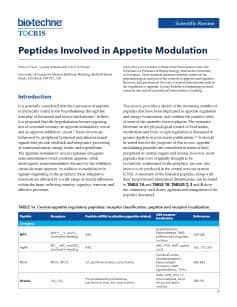Ghrelin Receptors
Ghrelin is the endogenous ligand for the ghrelin receptor, also known as the growth hormone secretagog receptor (GHS-R1a). Alternative splicing of preproghrelin yields two active peptides: ghrelin and des-Gln14-ghrelin, which differ by the deletion of one amino acid.
To view Bio-Techne's complete solutions for lipid metabolism, glucose homeostasis, and energy balance, please visit our metabolism page on bio-techne.com
Ghrelin Receptor Agonists |
|
|---|---|
| Cat. No. | Product Name / Activity |
| 1463 | Ghrelin (human) |
| Endogenous ghrelin receptor agonist | |
| 1465 | Ghrelin (rat) |
| Endogenous ghrelin receptor agonist | |
| 5272 | MK 0677 |
| High affinity ghrelin receptor agonist | |
| 2308 | Tabimorelin hemifumarate |
| Potent, orally active ghrelin receptor agonist | |
Ghrelin Receptor Inverse Agonists |
|
| Cat. No. | Product Name / Activity |
| 6347 | PF 04628935 |
| Potent ghrelin receptor inverse agonist | |
| 6350 | PF 05190457 |
| High affinity and selective ghrelin receptor inverse agonist | |
Ghrelin Receptor Antagonists |
|
| Cat. No. | Product Name / Activity |
| 1922 | [D-Lys3]-GHRP-6 |
| Ghrelin receptor antagonist | |
| 3959 | YIL 781 hydrochloride |
| Ghrelin receptor (GHS-R1a) antagonist | |
Other |
|
| Cat. No. | Product Name / Activity |
| 3374 | Cortistatin 14 |
| Endogenous neuropeptide; binds ghrelin receptor and sst1 - sst5 | |
Ghrelin is the endogenous ligand for the ghrelin receptor, also known as the growth hormone secretagog receptor (GHS-R1a). Alternative splicing of the preproghrelin yields two active peptides: ghrelin and des-Gln14-ghrelin, which differ by the deletion of one amino acid residue. The predominant form, ghrelin, is highly expressed in endocrine cells of the stomach, with low levels also found in the hypothalamus.
The G-protein-coupled ghrelin receptor is expressed in the pituitary, hypothalamus, hippocampus, gastrointestinal tract and the vasculature including the aorta, coronary arteries, pulmonary arteries, arcuate arteries, and saphenous veins. Ghrelin potently stimulates the release of growth hormone from the anterior pituitary. Ghrelin is thought to act on ghrelin receptors present on pituitary somatotrophs and on growth hormone-releasing hormone (GHRH) positive cells in the hypothalamus triggering GHRH release. The peptide also acts as a potent vasodilator in vivo and in vitro.
Ghrelin peptide was the first circulating hormone shown to stimulate eating and weight gain. In humans circulating ghrelin levels are decreased in acute states of positive energy balance and obesity, and are elevated during weight loss induced by sustained fasting and anorexia nervosa. The development of ghrelin antagonists, or a means to inhibit ghrelin release may be an important pharmaceutical goal for the management of obesity.
External sources of pharmacological information for Ghrelin Receptors :
Literature for Ghrelin Receptors
Tocris offers the following scientific literature for Ghrelin Receptors to showcase our products. We invite you to request* your copy today!
*Please note that Tocris will only send literature to established scientific business / institute addresses.
Peptides Involved in Appetite Modulation Scientific Review
Written by Sonia Tucci, Lynsay Kobelis and Tim Kirkham, this review provides a synopsis of the increasing number of peptides that have been implicated in appetite regulation and energy homeostasis; putative roles of the major peptides are outlined and compounds available from Tocris are listed.
